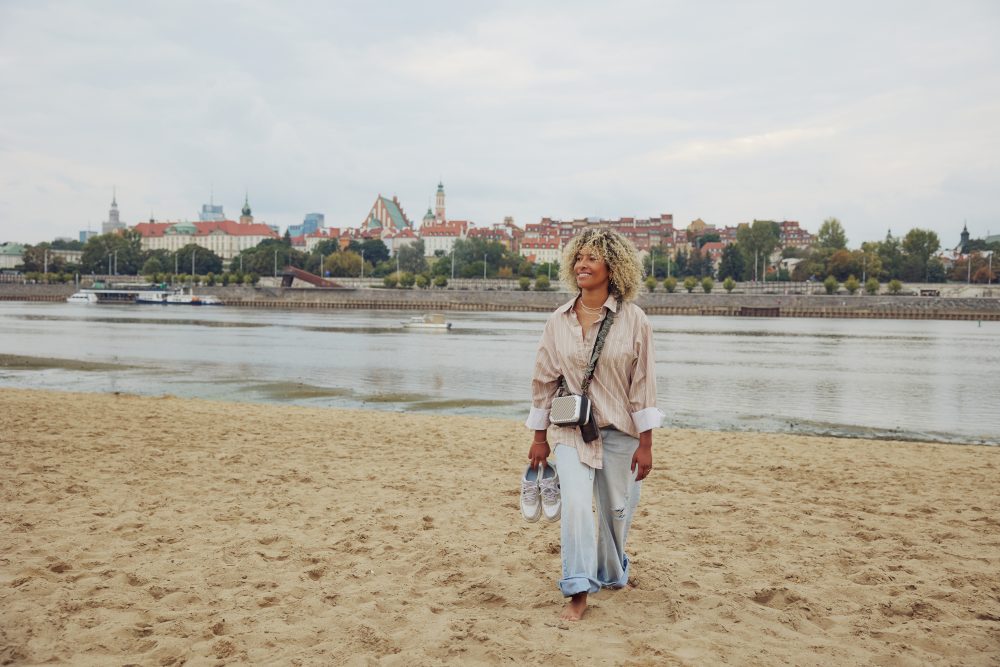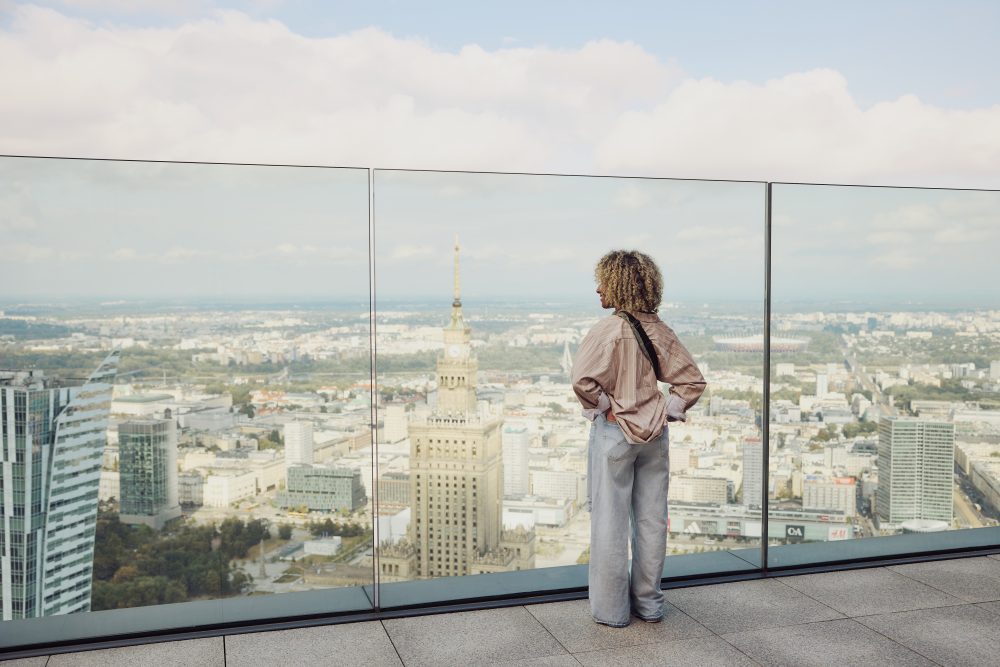Invincible Warsaw: Flowing through time, reaching for the sky
Warsaw is a city in constant motion. It rebuilds, reinvents, and reimagines itself, a place where traces of history meet bold new visions. Modern museums stand beside time-honoured monuments, Gothic spires rise alongside glass towers, and nature threads through the dynamic cityscape, in the green of its parks and the shimmer of the Vistula. Rooted yet full of momentum, Warsaw is both timeless and always becoming.
Warsaw Old Town: UNESCO jewel rebuilt from ruins
In the heart of one of Central Europe’s most modern metropolises lies a medieval jewel, a UNESCO World Heritage site meticulously reconstructed in the wake of World War II. Walking the narrow streets, the colourful houses seem to breathe centuries of stories, of conflict and resistance, uprisings and celebrations.
Guarding the entrance of the Old Town stands the Royal Castle, its red masonry glowing against the sky. This former home of Polish rulers holds some of Europe’s most precious artworks. Outside, King Sigismund III Vasa’s column points skyward, a striking landmark and a familiar meeting place. Around the corner lies one of Poland’s most hallowed sites, St. John’s Archcathedral. Once a wartime battleground, it was left in ruins. Today, its restored Gothic façade stands as a symbol of rebirth.
They say it’s impossible not to fall in love with Old Town Square, its form unchanged since it was built more than 700 years ago. Once the site of markets and festivals, trials and punishments, today it hums with café chatter and street musicians. In its centre, the Warsaw Mermaid stands guard. Said to have swum from the Baltic and vowed to protect the city, the emblem of Warsaw appears across monuments, gates, bridges, and even drain covers, a quiet treasure hunt through the streets. Some say she still rises from the Vistula, gazing at the ever-changing skyline.
Vistula River: Beaches, boulevards, and wild nature
From Gnojna Góra, once a city rubbish heap, unfolds a sweeping panorama of the Vistula and the Praga district beyond. On its balustrade, lovers fasten padlocks as a promise that their happiness will endure. A short walk further, the Stone Steps link the energy of the city with the calm of the river. The Vistula is Warsaw’s pulse, coursing not just through its neighbourhoods but through its spirit. The only unregulated river to flow through a European capital, it feels made for long walks, bike rides, water sports, and river cruises.
On the left bank, loungers and hammocks beckon lazy afternoons, cyclists sweep past, and music drifts from seasonal clubs. The restored Elektrownia Powiśle power plant buzzes with food halls and nightlife. At the Copernicus Science Centre, urban explorers uncover the wonders of nature through hands-on experiments. By the Świętokrzyski Bridge, another of Warsaw’s famous mermaid monuments gazes over the water, her sword aloft.
Cross to the river’s right bank, and the scene changes. You can walk for miles beneath willows, past sandy clearings, with the skyline glittering in the distance. Spanning the two banks is a pedestrian bridge, new and elegant, offering a view of the panorama as the river glides beneath.

Greenery and culture: Warsaw’s living landmarks
Not far from the river, gates open onto the University of Warsaw, a campus of quiet courtyards and historic halls. The University Library is one of Warsaw’s most striking buildings, a blend of raw concrete, green glass, and lush vegetation. From the hidden oasis that is the library’s rooftop garden, the city unfurls in every direction. Just beyond lies the Botanical Garden, small but rich with rose gardens, magnolia paths, and tropical greenhouses.
Following the Royal Route south, the grand avenue leads past embassies and historic residences before opening into Royal Łazienki Park, the summer residence of Poland’s last king, Stanisław August Poniatowski. Beneath the Chopin Monument, an art nouveau tribute to the great composer who grew up in Warsaw, free Sunday concerts by pianists from around the world keep his musical legacy alive.
Heading toward Warsaw’s modern downtown, among the towering skyscrapers are numerous gems of art, culture and science. Looming over the city is the Palace of Culture and Science. Once a gift from Stalin, today the palace belongs to Warsaw. Inside, grand halls host theatres, cinemas, and exhibitions, while the main tourist information office makes it a natural starting point for exploring Warsaw. After dark, lit in shifting colours, it dazzles, a monument transformed by the city that reclaimed it.
Modern Warsaw reaches its peak at the recently constructed Varso Tower. At 310 metres, the tallest building in Poland and the European Union is a symbol of the city’s ambition and forward-looking spirit. The view from its observation decks is unforgettable, with the Palace of Culture and Science so close it seems within reach. From up here, Warsaw feels both timeless and full of momentum, a city rooted in the past yet always looking upward.
Warsaw’s culinary discoveries: From milk bars to market halls
It is easy to understand why Warsaw has earned its place as the culinary capital of Poland, a city where tradition meets innovation on every plate. Culinary influences from across the world converge here, but the essence of Polish cooking – seasonal, hearty, and passed on through generations – still shines through.
Elegant restaurants near the Old Town serve Polish classics such as pierogi and żurek, while milk bars with their nostalgic interiors and simple home cooking preserve the everyday flavours of the city’s past. Reimagined industrial spaces add another dimension to Warsaw’s table: craft brews at the Warsaw Brewery, the bustle of Hala Koszyki’s market hall, and international dining at the former Koneser vodka factory in Praga. In Warsaw, food is never just sustenance: it’s atmosphere, heritage and discovery all at once.
A hands-on taste of tradition comes at Pierogi & More, where dumpling-making classes invite rolling, filling, and tasting while learning the stories behind the iconic dish. On the northeastern edge of the city, the Majlert farm in Białołęka shares a farm-to-table experience grounded in generations of family farming. Summer weekends bring communal meals at long tables set among the crops, savouring the flavours of the countryside within reach of the city.

Ever-evolving: Warsaw’s spirit endures
To wander Warsaw is to explore a city that has mastered the art of transformation. The Old Town embodies beauty born from survival, the Vistula weaves nature through the urban fabric, the university gardens offer reflection amid the tempo, and modern towers lift the skyline toward tomorrow. At its core lies an invincible resilience: an ability to rise from the ashes, to thrive anew, that gives Warsaw its unmistakable spirit.
